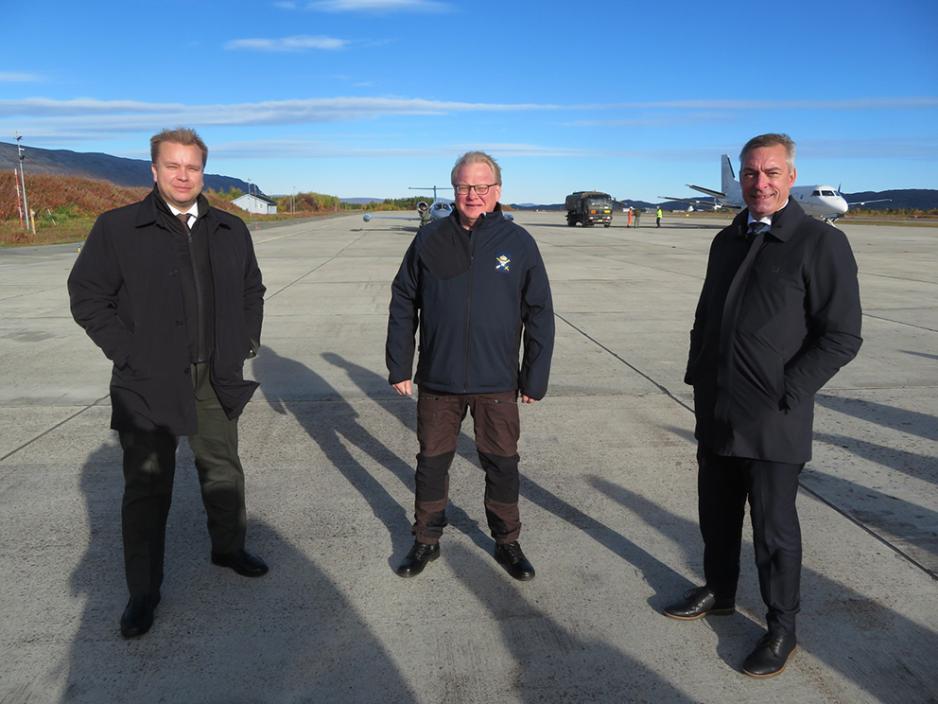Op-Ed Finland, Norway, Sweden and the trilateral military cooperation agreement

Antti Kaikkonen from Finland, Peter Hultqvist from Sweden and Frank Bakke-Jensen from Norge met in Porsanger, North Norway to sign the agreement. (Photo: Tonim Eriksson, The Swedish Ministry of Defense)
On September 23, Defence Ministers of Finland, Norway, and Sweden met at Porsangmoen Base in the Norwegian High North (Arctic) to sign a trilateral military cooperation agreement. The deal is essentially an updated version of a secret defence pact that the trio had concluded in the early1950s, argues Nima Khorrami of the Arctic Institute.
On September 23, Defence Ministers of Finland, Norway, and Sweden met at Porsangmoen Base in the Norwegian High North (Arctic) to sign a trilateral military cooperation agreement.
Coming at the back of a newly penned Nordic Defence Cooperation (NORDEFCO) framework agreement in 2018, the event has been hailed as a first practical step towards the realisation of improved defensive capabilities and closer cooperation amongst the signatories.
While it is certain that the deal is mainly about the fast evolving security situation in each country’s northern territories and the broader European Arctic region, information on the specifics of the agreement have been far few and in between.
Still, one could safely speculate that the deal is essentially an updated version of a secret defence pact that the trio had concluded in the early1950s[1]. Accordingly, one should expect a clear devision of labour between the Norwegian and Finnish-Swedish armed forces with regard to domain and geographical scopes of responsibilities.
Moreover, there will likely be increased efforts to coordinate air surveillance and air defence command and control while, simultaneously, putting in place common procedures for radio communication, reporting and identification processes.
Contrary to what has become a new normal in European discourses on the current status of transatlantic relations, however, this agreement is less about Helsinki, Oslo, and Stockholm’s concerns with unreliability of Washington’s as a security guarantor.
Rather, it has much more to do with these states’ fear of an American overreaction to increased Chinese and Russian activities in the Arctic.
Convinced that climate change constitutes the root cause of many of the challenges and opportunities in their northern territories, Finland, Norway and Sweden are keenly aware of the consequential effects of climate change on US’s continued ability to exercise its Monroe doctrine.
Put otherwise, as global warming gradually makes the Arctic Ocean more navigable and more actors establish a presence in the region, US may no longer be able to exercise full hegemony in its backyard.
Therefore, and given the historical context of relations between USA and Russia as well as the current, albeit unfounded, concerns with an emerging Sino-Russo partnership in the Arctic, Nordic states fear that paranoia and sensationalist threat perceptions might make Washington highly irrational in its efforts to reformulate its Arctic strategy.
Judging its recent activities and official statements, in fact, US already seems to have developed a zero-sum attitude based on a narrow conceptualisation of state security prioritising militaristic methods and sphere politics.
For instance, Mike Pompeo used his 2019 speech at the Arctic Council to securitise both China and Russia activities in the region claiming that the region has become “an arena for power and for competition”.
It has much more to do with these states’ fear of an American overreaction to increased Chinese and Russian activities in the Arctic.
He also used the occasion to issue an ultimatum to Beijing and Moscow by warning them of great consequences should they fail to respect US’s interests in the region.
His understanding of the region is also mirrored in the administration’s choice of its new Arctic envoy/coordinator Mr. Jim DeHart; a career diplomat whose main expertise is conflict resolution.
His appointment has been commonly described as an attempt to “blunt growing Russian and Chinese influence” in the Arctic, and hence it speaks volumes about current US’s stance on the Arctic and its future.
Washington seems to be expecting conflict and instability which is why it has sought to mimic Moscow and increase its military presence in the region.
As US’s relative power declines, conflict and protests continue to engulf Russia’s near-abroad, and both countries grapple with myriad domestic issues, there are real concerns amongst Nordic officials and strategists that both countries could become highly unpredictable in their conduct of foreign affairs.
As global power rivalry intensifies, moreover, neither side seems likely to substantially alter its current Arctic strategy. Moscow’s military build up will steam ahead unabatedly and US will continue to harden it hawkish and militaristic posture in response.
Sure, Moscow’s own economic interests compel it to avoid conflict and confrontation in the Arctic, and thus its military build up must not be hyper-securitised. However, It is hard to convince US officials of Kremlin’s benign intents when it religiously breaks the international law, habitually intimidates its smaller neighbours, including Finland, Norway, and Sweden, and shamelessly poisons its critiques at home and abroad.
What matters is not Moscow’s intention but what others believe to be its intention based on what it does.
As a result, Finland, Norway, and Sweden could find themselves dragged into a regional dispute that will be an extension of a wider global power rivalry. Should worse come to worst, these states will almost certainly side with Washington albeit in different capacities.
As such, the main objective behind their trilateral agreement is not to chart an independent path. Rather, it is to signal their collective ability and will to defend themselves. Given the commonly acknowledged observation that increased resiliency is, in and by itself, a credible form of deterrence, they hope their displayed resiliency will alter Russia’s strategic calculations while, at the same time, it convinces the US that its force mobilisation and/or deployment to Northern Europe needs not to be rapid.
While the former could ease US’s worries about Russian design for the European Arctic, the latter has the benefit of relaxing Russia’s threat perception; that is, a minimal or measured US military presence will go a long way in easing Russian’s concerns over an impending American military build up.
[1] see “Om kriget kommit”

